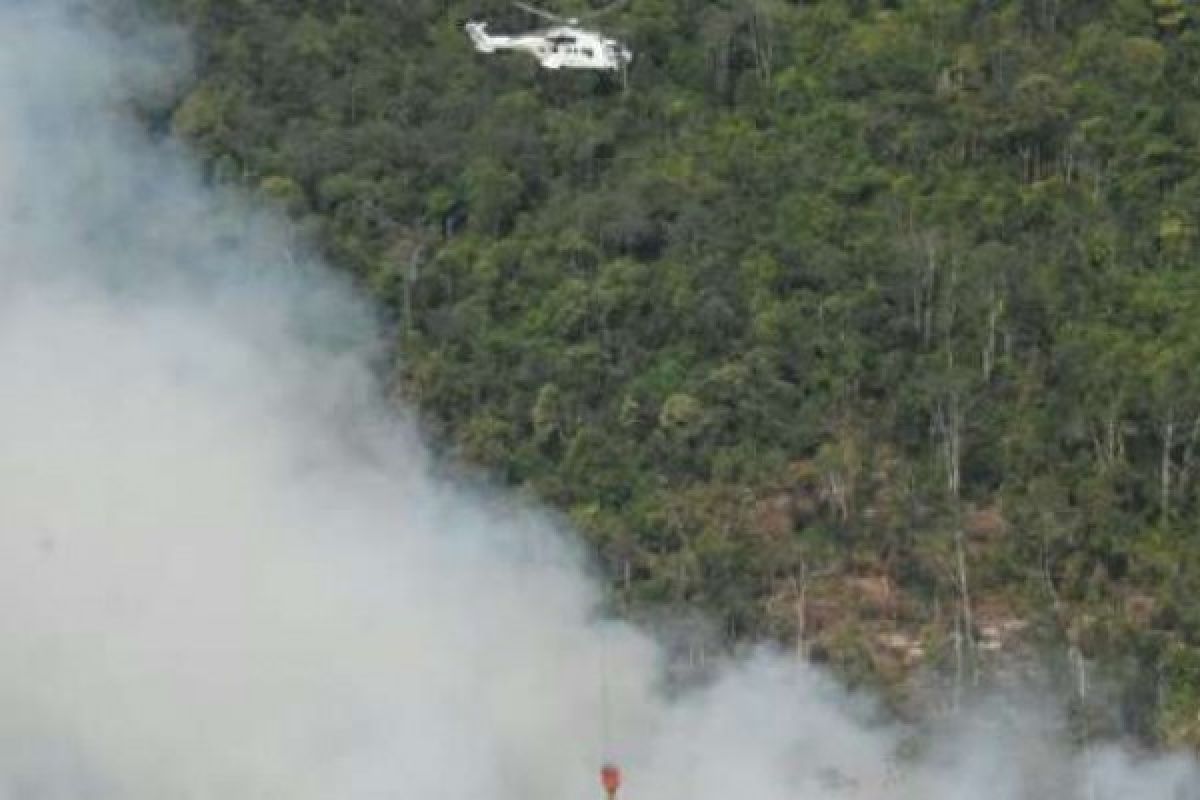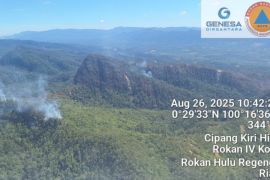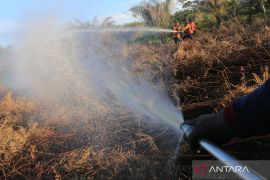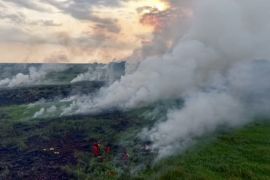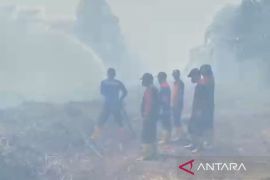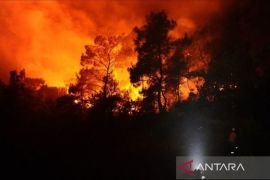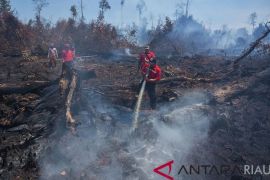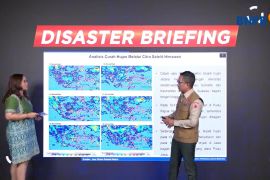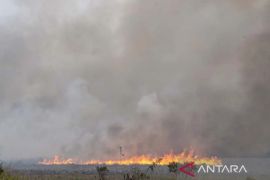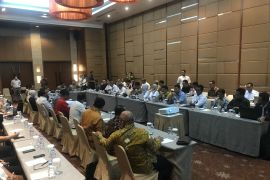Aboard helicopters, they reviewed the condition of nature at the Tesso Nilo National Park (TNTN), Indragiri Hulu, and Indragiri Hilir, among others, where wildfires razed forest and peatland areas.
In Jakarta, President Joko Widodo (Jokowi) had recently chaired a meeting at the State Palace to discuss efforts to combat forest fires. He instructed all-out efforts to extinguish the wildfires.
Eight provinces in Indonesia are prone to forest fires, but only six have declared an emergency status for forest fire, Director of Forest Fire Mitigation Raffles B. Panjaitan of the Environmental Affairs and Forestry Ministry stated.
The six provinces are Riau, with the emergency status declared from Feb 19 to Oct 31, or 255 days; West Kalimantan (from Feb 12 to Dec 31, or 323 days); South Sumatra (March 8-Oct 31, or 237 days); Central Kalimantan (May 28-Aug 26, or 91 days); South Kalimantan (June 1-Oct 31, or 153 days); and Jambi (July 23-Oct 20, or 90 days).
Based on satellite monitoring on Aug 10, at 7 a.m. local time, 126 hotspots were found in Riau, four in Jambi, 13 each in South Sumatra and South Kalimantan, 533 in West Kalimantan, and 159 in Central Kalimantan.
Fortunately, the smog, so far, emanating from forest fires had hung over the provinces of Riau, West Kalimantan, and Central Kalimantan though not descending over Singapore and Malaysia, National Disaster Mitigation Agency spokesman Agus Wibowo had stated on Aug 10, 2019.
However, the air quality has worsened in Pekanbaru, Riau, and Palangkaraya, Central Kalimantan. The concentrations of particulate matter (PM10) had reached 173, or considered unhealthy, in Pekanbaru, and 126, or moderate, in Palangkaraya.
The Health Ministry has urged people living in land-fire and forest fire-affected areas to avoid outdoor activities, so they are not exposed to smoke.
Director of Environmental Health of the Health Ministry Imran Agus Nurali stated that air pollution caused by wildfires could have an acute health impact in the short run.
Acute respiratory tract infection is a health disorder mostly found where the air quality is bad due to land and forest fires. The inspection may trigger other diseases among the people exposed to air pollution, he stated.
"Since it is acute, it could trigger asthma, hypertension, and heart disease for those running the risk of the diseases," he stated.
In Pekanbaru, at least 1,136 residents of Pekanbaru, Riau Province, ailed from upper respiratory tract infections following exposure to haze arising from forest fires.
All community health posts in Pekanbaru were notified to be prepared to deliver optimal services to patients with respiratory ailments, Mohammad Amin, acting head of the Pekanbaru health office, had stated recently.
Most outpatients were people belonging to the productive age group that often conducted outdoor activities, he explained.
He called on Pekanbaru residents to watch out for their health and remain indoors at a time when haze blankets their city.
In South Sumatra, forest fires resulted in 274,502 people suffering from acute respiratory tract infection during the January-June 2019 period.
Palembang is the worst-affected area, with 80,162 residents suffering from the infection over the period of time, followed by Banyuasin District, with 36,871 sufferers; Muara Enim District, with 35,405 patients; Musi Banyuasin District, with 21,871 cases; and Ogan Komering Ilir District, with 13,292 ailing.
In Palangka Raya, the Central Kalimantan authorities temporarily closed schools owing to haze arising from wildfires.
Palangka Raya’s air pollution standard index (ISPU) on Aug 12, 2019, indicated that air quality in the area had reached 650, or very dangerous for people's health.
The Meteorology, Climatology, and Geophysics Agency (BMKG) recorded that the air quality index in Palangka Raya City had reached 148.10 micrograms per cubic meter.
In addition to the public’s health, smog arising from forest fires in West Kalimantan also threatened business activities and prospects in the province, Chairman of the Indonesian Businessmen Association (Apindo) chapter in Pontianak Andreas Acui Simanjaya stated.
"The impact of haze has been huge, both on health and business. This necessitates attention from all parties," he remarked in Pontianak on Aug 10.
He cited that smog from forest fires could affect public health and flight schedules, trigger complaints from neighboring countries, and waste both finances and energy of the government that has to work hard to put out the wildfires.
Smog during every dry season has become a scourge since long, and it had yet to be tackled permanently. “We only react when the condition is bad. Such repeated incidents have wasted significant amounts of energy of various parties that have to deal with it," he pointed out.
Simanjaya suggested two solutions to stop forest fires, the first being increasing public awareness to ensure that the practice of setting fires for land clearance is halted. Second, legal enforcement must be imposed firmly to deter others from burning forest and peatland areas.
The Indonesian Environmental Affairs and Forestry Ministry recorded 2,070 hotspots, with a confidence rate at over 80 percent, during the January-July 2019 period, based on monitoring of the Terra and Aqua Modis satellites.
"The number of hotspots was higher than that in 2018 but lower than that recorded in 2015," Eva Famurianty, head of the Early Warning and Detection Section of the Climate Change Mitigation Directorate General of the ministry, remarked in Jakarta, recently.
In 2018, the number of hotspots across Indonesia had reached 1,338, up from 362 in 2017.
During the same period, the Landsat satellite image indicated that a total of 135,747 hectares of forest areas were razed by fires. The indicative gutted forest areas comprised 31,002 hectares of peatland areas and 104,746 hectares of mineral land areas.
Indonesia is currently experiencing severe dry spell induced by El-Nino natural phenomenon that has led to a water crisis and forest fires in several provinces.
Editor: Rahmad Nasution
Copyright © ANTARA 2019
